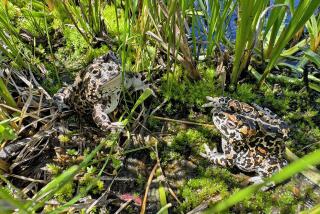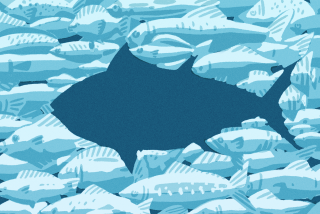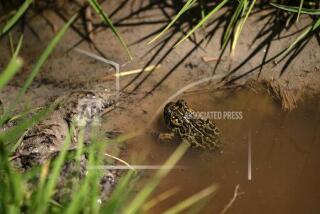Fido-Munching Toads Take Florida by Leaps and Bounds
- Share via
MIAMI — In one of those examples of man foolishly messing with nature, a huge kind of South American toad was let loose in Florida and other parts of the world earlier this century to try to control sugar cane pests.
Big mistake.
The Bufo marinus, or marine toad, can grow to 7 inches or more and weigh more than 3 pounds. They are overrunning part of Australia. They’re scaring tourists in the Caribbean. And occasionally they’re killing dogs in Florida with a poison so potent that the family pets die in a matter of minutes.
“Someone got this wild idea it would increase sugar cane production. It didn’t,” said University of Miami biologist Jay Savage. “You’d have to have bumper-to-bumper toads to increase a crop.”
“Now they’ve become a pest themselves,” Savage said.
Bufo marinus resembles Jabba the Hutt of “Star Wars,” with deeply pitted, swollen glands behind each eye, extending down the back. The glands contain a milky white toxin that the toad secretes when threatened. The animal’s call sounds like a tractor in the distance.
Dogs who find all this too tempting to pass up suffer the consequences if they touch the toads with their tongues. Vivian Gil’s Dalmation, Jazz, barely survived one such confrontation recently outside her home in western Dade County, on the edge of the Everglades.
“It looked like he was having spasms or something. It felt like his brain was going to explode,” she said. “It was very scary.”
Some people try to use the poison of the toad and its cousins as an aphrodisiac and a hallucinogen. The substance was sold until last year in grocery stores and tobacco shops in the United States but is now banned.
“Four New York men purchased it, thinking it was an oral aphrodisiac. They died,” said Dr. Rossanne Philen, an epidemiologist at the Centers for Disease Control and Prevention in Atlanta. The substance was supposed to be rubbed on the genitals.
“A few years ago there was a fad of licking the toads because people thought they were a hallucinogen,” Savage said. “Other people tried to extract and sniff it.”
In fact, Maya Indians in Mexico use the toxin as a hallucinogen in their religious ceremonies.
In Florida, “there are a few dogs killed every year. Cats are usually smarter. When they see something that big, they leave it alone,” Savage said. “If a dog gets a good shot of the toxin, it can kill it. The first sign is that the dog starts frothing at the mouth.”
If a dog spits out the toxin, the toad just ends up ruining the dog’s day. But if the dog swallows the poison, death can be quick. In humans, the toxin generally isn’t enough to stop the heart, but it can irritate the mucous membranes, Savage said.
Bufo marinus is native to Latin America from Brazil to Mexico. It was introduced into Puerto Rico in the 1920s, into Hawaii, the Philippines and Australia in the 1930s and South Florida in the 1940s, Savage said. It has spread to southern Texas but cold winters keep it out of the rest of the United States.
The toads will eat just about anything, including insects, small birds, snakes, table scraps and vegetation. Sometimes they can be found feeding on cat food or dog food if the pet’s dish is left outside at night.
Florida wildlife officials haven’t tried to eradicate the toads and can’t say for sure how many there are.
In Queensland, Australia, the toads have become so numerous that they are poisoning ranchland water holes when they get into ponds and die, Savage said. Scientists there are testing a virus that seems to kill the toads.
More to Read
Sign up for Essential California
The most important California stories and recommendations in your inbox every morning.
You may occasionally receive promotional content from the Los Angeles Times.













